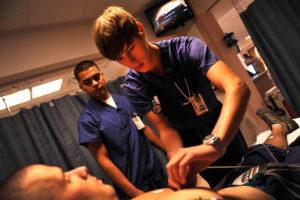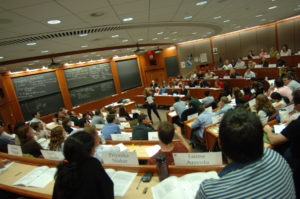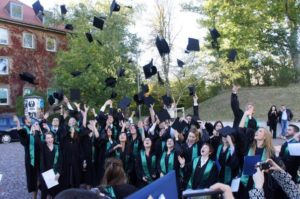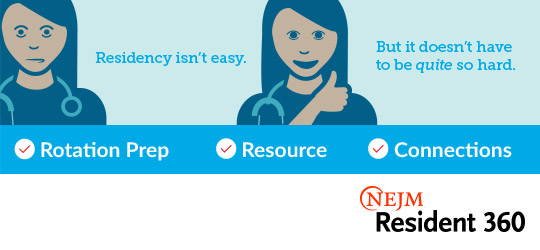May 31st, 2017
What I Love About My Medical Students
Kashif Shaikh, MD

Kashif Shaikh, MD, is the 2016-17 Chief Resident in Internal Medicine at the University of Central Florida College of Medicine.
We all start with medical school
I still remember the day I got the welcome letter from my medical school. I was super excited and proud. My dreams of becoming a physician were now a reality. So, I pushed myself during my two basic science years and awaited my clinical years.
I bought my first stethoscope and white coat in anticipation of my third year. (By the way, I still have the stethoscope that I bought almost 15 years ago, and it is the only stethoscope I still use.) I started my first rotation in community health sciences and family medicine. I was thrilled! But, the first patient I saw described his chief complaint in a most interesting way. My patient said, “I have a gas that starts in my stomach and goes into my head.” Even though I have been practicing history-taking for some time, it took me a moment to collect myself and to complete that medical history. Anyway, things got better with time. Nothing beats being a third year senior medical student in a white coat with a stethoscope hanging around your neck.
I began my medicine clerkship. By that time, I could take a comprehensive history and physical without losing a beat. I started interacting more with residents and attendings. I wanted to be a teacher, and I started identifying role models.During medical school, I knew what kind of resident I wanted to be. I wanted to develop the same virtues that I admired in my role models: Kindness, passion, and dedication to teaching, and supportive and encouraging when the medical education process became very stressful. I wanted to be my students’ biggest support in a nurturing environment. I wanted to make learning fun, easy, and enjoyable. And I wanted to guide them through all phases of learning, from the medicine wards to residency applications.

By U.S. Navy photo by Mass Communication Specialist 2nd Class Gary Granger Jr. [Public domain], via Wikimedia Commons
A plan for teaching medical students
As an attending and a chief resident, I have been applying some of the key concepts about teaching medical students that I learned at the APDIM chief resident meeting.
- 1. I start orienting medical students on day 1. I discuss learning objectives, expectations, and how they can get the most out of their internal medicine rotations. I explain the residency match process in detail. I guide them on how to get LORs and write personal statements.
- 2. We do 1-hour teaching sessions, three times weekly. Each student gives a 10-minute presentation (2 students per session) to learn how to present and to become teachers — as residents and attendings, I hope they will carry on this tradition. They receive feedback and some clinical pearls, and we work on board questions with explanations and test-taking skills and strategies.
- 3. To help develop clinical reasoning, we have a student-style morning report session. We simulate an actual patient scenario. I ask them to take a history and to tell me what they would do on the physical exam to come up with a differential diagnosis. Then I ask them to narrow it down, based on labs and imaging they would order.
- 4. I assign new patients to a medical student and an intern. The patient sees the student first, followed by the intern. We all sit down and critique the student’s presentation of the case. Then I round with them to do bedside teaching. Our team comes up with a consolidated plan for the next day’s rounds. With this teaching method, students begin to master clinical reasoning.
The best part of being an educator
I hear a lot of people complain about medical students. Do teachers and educators take responsibility for orienting them and teaching them? Patient care can be time-consuming, but students need direction. What’s the point of being on a rotation if no one is teaching? We have all been students. Engaging students more, and emphasizing how important they are as team members, makes a huge difference.
I am amazed by medical students’ learning potential. They just need a little motivation to get things moving. I ask these students to be the future educators and be role models for their future students. Students learn best when they are given constructive and objective feedback through examples.I am very proud of my medical students. They are my responsibility when they are rotating with us, and they should get maximum education out of the rotation. I dedicate this blog to all the medical students who are our future educators and physicians. Make us proud. Work hard, and don’t let anyone discourage you. There is a reason why you were selected for medical school. Best wishes and good luck to everyone in their future goals.
-
- “What the caterpillar calls the end of the world, the Master calls a butterfly.” – Richard Bach







I’m a 3rd year student and reading this is refreshing. Its nice to know that out there, there are people who do care about the medical student. I wish I encountered more residents like you, as my 3rd year was very difficult because none of the things you suggested like guidance, orientation, and expectations were implemented. I think those few things would have helped me tremendously.
My education was not even a concern to the residents, so it really hindered my learning.
I hope that upcoming fourth year is much better!
I am also a 3rd year medical student – unfortunately it seems that most residents are not as dedicated to guiding their students. If only someone would give us clear guidance even just for the first two days of a rotation (e.g. show us how to remove an NG tube or foley), we would be able to help so much more for the next 8 weeks! Instead, we are left trying to piece everything together ourselves, learning things incorrectly, and wandering the floors unsure of what to do next, in addition to being met with a set of rolling eyes every time we ask a resident or nurse how to do anything